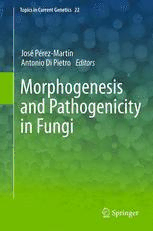
Morphogenesis and Pathogenicity in Fungi PDF
Preview Morphogenesis and Pathogenicity in Fungi
Topics in Current Genetics 22 Series Editor: Stefan Hohmann For furthervolumes: http://www.springer.com/series/4735 . Jose´ Pe´rez-Mart´ın Antonio Di Pietro l Morphogenesis and Pathogenicity in Fungi Editors Jose´Pe´rez-Mart´ın AntonioDiPietro CentroNacionaldeBiotecnologia UniversityofCordoba CSIC DepartmentofGenetics DepartmentofMicrobial CampusRabanales,Edificio Biotechnology GregorMendel CampusdeCantoblanco Cordoba Madrid Spain Spain [email protected] [email protected] ISBN978-3-642-22915-2 e-ISBN978-3-642-22916-9 DOI10.1007/978-3-642-22916-9 SpringerHeidelbergDordrechtLondonNewYork LibraryofCongressControlNumber:2011941775 #Springer-VerlagBerlinHeidelberg2012 Thisworkissubjecttocopyright.Allrightsarereserved,whetherthewholeorpartofthematerialis concerned,specificallytherightsoftranslation,reprinting,reuseofillustrations,recitation,broadcasting, reproductiononmicrofilmorinanyotherway,andstorageindatabanks.Duplicationofthispublication orpartsthereofispermittedonlyundertheprovisionsoftheGermanCopyrightLawofSeptember9, 1965,initscurrentversion,andpermissionforusemustalwaysbeobtainedfromSpringer.Violations areliabletoprosecutionundertheGermanCopyrightLaw. Theuseofgeneraldescriptivenames,registerednames,trademarks,etc.inthispublicationdoesnotimply, evenintheabsenceofaspecificstatement,thatsuchnamesareexemptfromtherelevantprotective lawsandregulationsandthereforefreeforgeneraluse. Printedonacid-freepaper SpringerispartofSpringerScience+BusinessMedia(www.springer.com) Topics in Current Genetics publishes review articles of wide interest in volumes thatcenteraroundaspecifictopicingenetics,genomicsaswellascell,molecular and developmental biology. Particular emphasis is placed on the comparison of severalmodelorganisms.Volumeeditorsareinvitedbytheserieseditorforspecial topics,butfurthersuggestionsforvolumetopicsarehighlywelcomed. Each volume is edited by one or several acknowledged leaders in the field, who ensurethehigheststandardofcontentandpresentation.Allcontributionsarepeer- reviewed. AllvolumesofTopicsinCurrentGeneticsarepartoftheSpringereBookCollec- tion. The collection includes online access to more than 3,500 newly released books, book series volumes and reference works each year. In addition to the traditional print version, this new, state-of-the-art format of book publications giveseverybookaglobalreadershipandabettervisibility. Editorialoffice: TopicsinCurrentGenetics SeriesEditor:StefanHohmann CellandMolecularBiology Go¨teborgUniversity Box462 40530Go¨teborg,Sweden FAX:+46317862599 E-mail:[email protected] . Preface Fungal diseases cause human suffering and enormous economic losses. New approaches for antifungal control are instrumental in meeting the threat imposed bytheseinfectiousagents.Suchconceptualadvancesareonlypossiblethroughthe identification of novel biochemical and molecular targets in the fungal cell. The great diversity that exists among pathogenic fungi in terms of lifestyles, infection strategies, and disease symptoms represents a major challenge in the search for common antifungal targets, because it is likely that different attributes will be important for different fungi to cause disease. However, all pathogens share a common need for making the appropriate developmental decisions during induc- tionofthepathogenicprogram.Suchdevelopmentalswitchesareoftenassociated withdifferentiationprocessesthatrequirearesetofthecellcycleandtheinduction ofanewmorphogeneticprogram.Theabilityofpathogenicfungitomodulatetheir cell cycle and morphogenesis is emerging as a key determinant for successful infection. In the past, experimental approaches to understand regulation of the pathogenic developmental program have focused on the study of signal transduc- tion pathways and transcriptional changes. Today, the study of how genetic viru- lenceprogramscontrolmorphogenesisandcellcycleoffersexcitingopportunities toexplorethemolecularbasisoffungalpathogenicityundernewangles,whichat thesametimearecomplementarytopreviousapproachesinthefield. Inthelastyearstherehasbeenatremendousincreaseintheamountofresearch and relevant data on the relationships between morphogenesis, cell cycle, and regulation of virulence programs in pathogenic fungi. This progress has been the subjectofanumberofexcellentreviewsovertheyears.Sofar,however,thefield haslackedamonographiccollectionwheremanyoftheseimportantcontributions andviewsarejoinedtogether.Inthisbookweattemptedtocoverabroadspectrum oftaxonomicallyandbiologicallydiversefungalpathogens,aswellasanumberof key topics related to morphogenesis and pathogenesis. The double aim was to provideintroductorymaterialforthenonspecialistandalsotoofferthemostrecent andupdatedviewsonthesecrucialcellbiologicalprocesses. vii viii Preface The book is organized in 13 chapters written by qualified researchers on each topic.Eachchaptercontainsanintroductionfollowedbyanin-depthandup-to-date analysis of the current state of knowledge on the subject. The chapters were conceived and written autonomously, so that they can be read independently, eventhoughthismayhaveresultedinsomerepetitivenessofbasicconcepts. Finally,wewanttothankeachandeveryauthorforhis/herexcellentcontribu- tion. We are also indebted to the anonymous reviewers who read and made important suggestions to improve the chapters. We also thank Stefan Hohmann forhisconstantencouragementduringtheeditingprocessandthestaffatSpringer Verlagfortheircontinuoushelpandsupporttomakethisbookpossible. Madrid/Co´rdoba Jose´ Pe´rez-Mart´ınandAntonioDiPietro Contents 1 MolecularBasisofMorphogenesisinFungi ............................ 1 StevenD.Harris 2 TropicOrientationResponsesofPathogenicFungi ................... 21 AlexandraBrandandNeilA.R.Gow 3 HyphalFusion ............................................................ 43 Andre´ Fleißner 4 SignalingofInfectiousGrowthinFusariumoxysporum .............. 61 ElenaPe´rez-NadalesandAntonioDiPietro 5 IntegratingCdkSignalinginCandidaalbicansEnvironmental SensingNetworks ........................................................ 81 CarlosR.Va´zquezdeAldanaandJaimeCorrea-Bordes 6 CellCycleandMorphogenesisConnectionsDuringtheFormation oftheInfectiveFilamentinUstilagomaydis ........................... 97 Jose´ Pe´rez-Mart´ın 7 AppressoriumFunctioninColletotrichumorbiculareandProspect forGenomeBasedAnalysis ............................................ 115 YasuyukiKubo 8 MorphogenesisinCandidaalbicans:HowtoStayFocused ......... 133 MartineBassilanaandPeterFollette 9 MorphogenesisinParacoccidioidesbrasiliensis ....................... 163 IranMalavaziandGustavoHenriqueGoldman ix x Contents 10 MorphogenesisofCryptococcusneoformans .......................... 197 ElizabethR.Ballou,J.AndrewAlspaugh,andConnieB.Nichols 11 MorphogenesisandInfectioninBotrytiscinerea ..................... 225 JuliaSchumacherandPaulTudzynski 12 Morphogenesis,Growth,andDevelopmentoftheGrass SymbiontEpichlo¨efestucae ............................................ 243 BarryScott,YvonneBecker,MatthiasBecker,andGemmaCartwright 13 Cryptococcus–NeutrophilInteraction ................................. 265 AsfiaQureshiandMaurizioDelPoeta Index .......................................................................... 281
